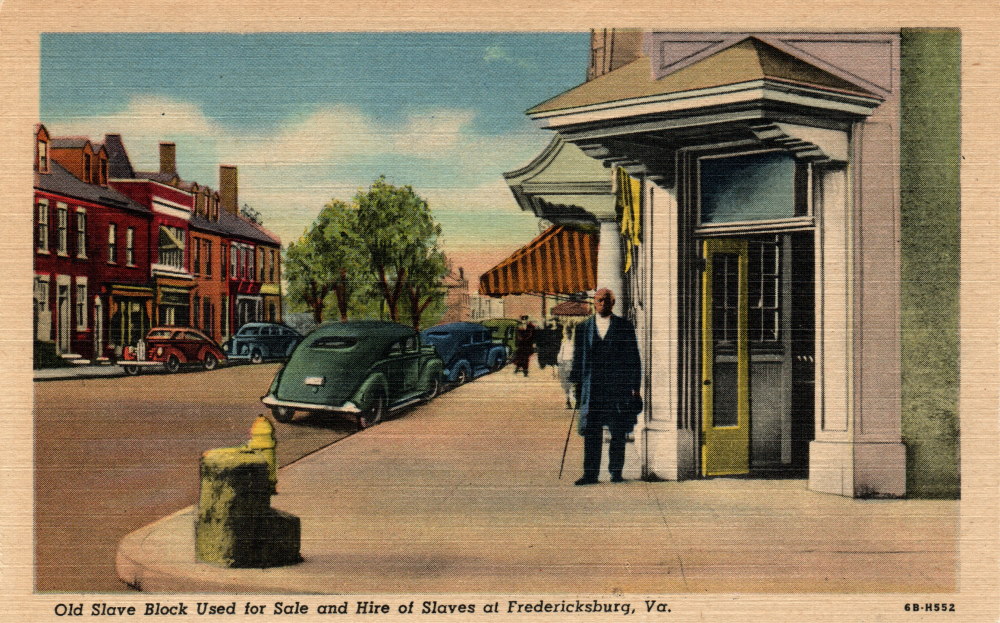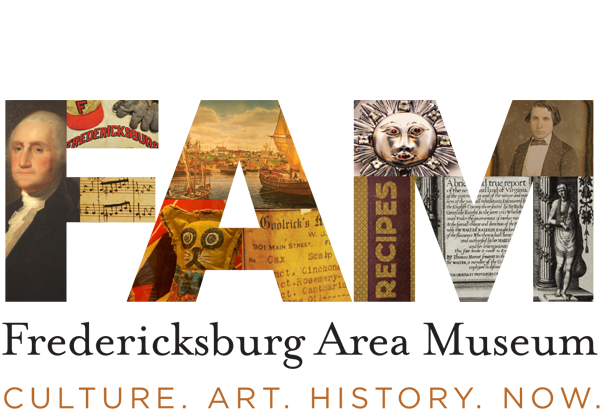
The Auction Block’s value comes not only from its historical significance but also from the emotions and memories associated with it, in addition to its role in stimulating continuing conversations about racial injustice. Here is a selection of quotations, oral histories, remembrances, written references, comments, and social media posts from community members, area residents, and visitors from near and far, collected by the Fredericksburg Area Museum.

One of the most widely recognized early images of the Block, this postcard features a formerly enslaved man named Albert Crutchfield posing next to the Block in 1931. The back of the postcard reads, “Albert Crutchfield…was sold from the block about 1859, at which time he was a boy about fifteen years old.”
Reflections
”We should be uncomfortable. And we should never forget. We cannot change what this community has gone through. `{`The Block`}` speaks to the experience of generations of people before me. Every time I walk by that, there's a twinge in my gut.
Cedric Rucker
Resident of Fredericksburg, quoted in “Slave Auction Block Vandalized,” The Free-Lance Star, May 6, 2005.
”There’s probably some benefit of having these types of places so that people can hear the story, understand the story and never repeat the story, but it’s just as important if you can remove pain and sadness by placing it in a museum. I think you ought to do that as well. We can still tell the story and describe it in detail, but it evokes the most sadness and pain, and I’ve seen it for 20 years.
Jervis Hairston
Resident of Fredericksburg, quoted in “Fredericksburg Slave Auction Block Has History of Controversy, The Free-Lance Star, August 26, 2017.
”We must do better by learning the real + unwashed history, so real change can happen through honest conversations.
Fredericksburg Area Museum Visitor
September 2022
”A sobering reminder of human cruelty that must never be repeated.
Fredericksburg Area Museum Visitor
August 2022
”Because the black slaves had NO VOICE back then, please LISTEN most closely, and REALLY create comfortable spaces, to encourage + HEAR Black Voices MOST LOUDLY, NOW.
Participant
International Coalition of Sites of Conscience, City of Fredericksburg: Phase Three Report, 2019
”I started this history thing when I was a young boy for my grandmother. She was born in 1895 and she hated it `{`the slave auction block`}` and was outraged every time she walked by - because her mother had been enslaved…. City Council voted for it to stay ‘for now.’ I am confident that the next generation will demand that it be removed.
Participant
International Coalition of Sites of Conscience, City of Fredericksburg: Phase One Report, 2018
”I looked at the slave auction block every day. It represented a sad part of our history and I thought it was important to be reminded of that. Up until the other day, I was pretty convinced that it needed to stay…. I talked to a black mother who…said when she walks down the street with her children it’s humiliating to her - especially if you just happen upon it. And, I have changed my opinion. I think, perhaps, it should be moved to the museum where it can be presented with more depth.
Participant
International Coalition of Sites of Conscience, City of Fredericksburg: Phase One Report, 2018
”When I was young, we played on the auction block too; I didn’t know what it was and we didn’t have any idea, but played on and around it. The slave block represents part of history like a knot. People and property were auctioned there. It is a part of our history and we need to build on it and understand it. If you destroy the physical space then you lose the memory of it. I want it to be enhanced.
Participant
International Coalition of Sites of Conscience, City of Fredericksburg: Phase One Report, 2018
”I have been interested in Fredericksburg since I was a small kid. My grandmother’s grandmother saw her brother sold at the slave block. She never wanted us to forget. That is one of the reasons why I’ve always been interested.
Participant
International Coalition of Sites of Conscience, City of Fredericksburg: Phase One Report, 2018
”All right, let’s take on the corner of Charles and William Street--the Knoxanna Apartments. When I lived there--I remember my aunt who raised me--from a small child then--forbade me to sit on that block ever. And she was very emphatic about it. At that time, I didn’t know why. Later, I found out why. And--I never sat on that block. But, do you want to know what I later found out? I understand that during those days, the tourists would come through town and would say, let’s get a little pickaninny to sit on that block and it was representative of slaves being sold on that block. I don’t know how it is marked today. But we were taught it was the old slave block where they would put slaves on the block and sell them. I later learned that’s why my Aunt Lena insisted that I never sit on that block. Now, that was my most distinctive memory of living in that particular area.
Mrs. Gladys Poles Todd
Oral History Interview Conducted on March 6, 1998 (Courtesy Virginiana Room at Fredericksburg Branch of Central Rappahannock Regional Library)
”In Fredericksburg, many slaves were hired out or sold on the slave block, also used as a carriage block, at the northwest corner of William and Charles Streets, in front of what was the Planter’s Hotel. Blacks were displayed on this block and an auctioneer called attention to their good points, sometimes producing a doctor’s certificate or allowing prospective buyers to feel their muscles and otherwise examine them.
Ruth Coder Fitzgerald
A Different Story: A Black History of Fredericksburg, Stafford, and Spotsylvania, Virginia, 1979 (Page 27)
”At the corner of Commerce and Charles streets, in front of this hotel, is a stone block about two and a half feet high and some two feet in diameter. It was placed there many years before the Civil war, it is said, for the sale and annual hire of slaves. The slave to be sold was required to stand on this block in the presence of the gathered traders, when he or she was “cried out” by the auctioneer to the highest bidder. Those slaves who were publicly hired out for the year also took their stand on this block and were hired out at the highest price bid. There is probably no relic in Fredericksburg that calls back more vividly the days of slavery than does this stone block.
S.J. Quinn
History of the City of Fredericksburg, 1908 (Page 168)
”I’ve lived in Fredericksburg for the majority of my life. The first time I saw the ‘Auction Block,’ I was a teenager walking downtown. At the time, I knew the significance of it, but it wouldn’t be until some years later when I realized how much profit was made by slaveholders through selling people who looked like me. During the 2020 summer protests, I was a first-hand witness to see how the ‘auction block’ was used as a gathering space for young protesters who were demanding better of their country and the people paid to protect and serve our communities. Their brave, spirited actions led to the removal of it, after years of meetings about what to do with it. I will cherish those memories of those demonstrations, and how they changed this community for the better.
Chris Williams
Fredericksburg Resident, September 2022
”That Auction Block is an artifact. The very fact that you can stand where somebody was treated as property and where families were separated, is very moving…Don’t ever forget. You can’t ever forget how horrible that was.
Mayor Mary Katherine Greenlaw
quoted in “Stone Ghosts in the South: Confederate Monuments and America’s Battle with Itself,” which aired on NBC News on June 4, 2020
”The Auction Block had been on my mind for a long time, since I was a kid. I used to see people spit on it and I saw a mock auction, where folks did a mock auction. That rips your soul apart.

